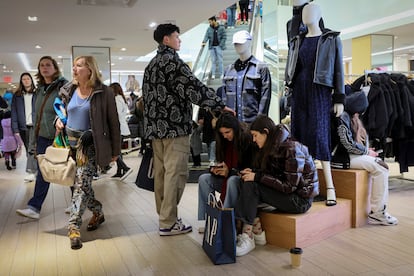US economy grows at fastest pace since 2021 on the back of strong consumer spending
Gross domestic product expanded at an annualized rate of 4.9% in the third quarter despite interest rate hikes


A few months ago, the script for the U.S. economy contemplated that the country would be entering a recession at this time of the year, hit by the rise in interest rates. But the strength of the job market and consumer spending have defied all expectations, and the largest economy in the world has not only not slowed down, but actually accelerated its growth in the third quarter of the year, posting the fastest pace since late 2021. Gross domestic product (GDP) grew at an annualized rate of 4.9% between July and September, according to the first estimate published Thursday by the Bureau of Economic Analysis (BEA) of the Commerce Department.
Experts attribute this surge in consumer spending, which represents more than two-thirds of the U.S. economy, to temporary factors that boosted spending on leisure and entertainment. Taylor Swift’s (and to a lesser extent, Beyoncé's) concert tours broke records and attracted tourists to the cities they passed through. The release of the Barbie and Oppenheimer movies brought more consumers to movie theaters, with the additional spending associated with those outings. In general, Americans took advantage of the summer to travel and go out more, once the pandemic restrictions were forgotten and with some of the available savings pool still accumulated.
Added to this was a clearly expansive fiscal policy, a moderation in inflation and salaries that began to recover purchasing power. Retail sales figures for September surprised analysts with growth of 0.7%, more than double what economists had been expecting. Companies have also been investing in new factories and replenishing their stocks, boosting production. This offset the slowdown in the sectors most sensitive to interest rates, such as residential real estate.
The growth represents an acceleration compared to the annualized rate of 2.1% in the second quarter, and the 2.2% of the first. “The increase in real GDP reflected increases in consumer spending, private inventory investment, exports, state and local government spending, federal government spending, and residential fixed investment that were partly offset by a decrease in nonresidential fixed investment. Imports, which are a subtraction in the calculation of GDP, increased,” said the BEA in a statement.
Economists consider the pace of growth in the third quarter to be unsustainable, and they have not yet ruled out that the economy will go through a mild recession at the end of the year or in the first half of 2024. Tighter financial conditions with rising long-term interest rates, conflicts in Ukraine and the Middle East, strikes and the threat of a partial government shutdown have clouded the outlook.
At a conference in New York last week, Federal Reserve Chairman Jerome Powell boasted about the soft landing of the U.S. economy, but admitted that the battle against inflation is not yet won and left the door open to further increases in interest rates. He hinted, however, that there would be no rate hike at the next monetary policy meeting, which ends November 1.
For U.S. President Joe Biden, the good figures for job creation and economic growth are proof that his economic policy is working. High inflation and high interest rates, however, are causing Americans to take a dim view of the economic situation.
Sign up for our weekly newsletter to get more English-language news coverage from EL PAÍS USA Edition
Tu suscripción se está usando en otro dispositivo
¿Quieres añadir otro usuario a tu suscripción?
Si continúas leyendo en este dispositivo, no se podrá leer en el otro.
FlechaTu suscripción se está usando en otro dispositivo y solo puedes acceder a EL PAÍS desde un dispositivo a la vez.
Si quieres compartir tu cuenta, cambia tu suscripción a la modalidad Premium, así podrás añadir otro usuario. Cada uno accederá con su propia cuenta de email, lo que os permitirá personalizar vuestra experiencia en EL PAÍS.
¿Tienes una suscripción de empresa? Accede aquí para contratar más cuentas.
En el caso de no saber quién está usando tu cuenta, te recomendamos cambiar tu contraseña aquí.
Si decides continuar compartiendo tu cuenta, este mensaje se mostrará en tu dispositivo y en el de la otra persona que está usando tu cuenta de forma indefinida, afectando a tu experiencia de lectura. Puedes consultar aquí los términos y condiciones de la suscripción digital.
More information
Archived In
Últimas noticias
Rowan Atkinson tops Netflix at 70: ‘He’s as funny as ever’
Israeli recognition of Somaliland stirs up the Gulf
Tiger Woods turns 50: Will he continue playing on the PGA Tour or take a back seat?
The surreal journey of James Nnaji, the Barcelona youth player selected in the NBA Draft who ended up in the NCAA
Most viewed
- Oona Chaplin: ‘I told James Cameron that I was living in a treehouse and starting a permaculture project with a friend’
- Reinhard Genzel, Nobel laureate in physics: ‘One-minute videos will never give you the truth’
- Sinaloa Cartel war is taking its toll on Los Chapitos
- Why the price of coffee has skyrocketed: from Brazilian plantations to specialty coffee houses
- Chevy Chase, the beloved comedian who was a monster off camera: ‘Not everyone hated him, just the people who’ve worked with him’










































